LED lamps for the home: which diode bulbs are better, LED lamp manufacturers overview
The first step towards energy-efficient housing is the use of energy-efficient light sources. Fully this criterion corresponds to diode bulbs, offered for sale by a wide range. In order not to make a mistake in the choice, it is necessary to understand the design features of different LED devices.
We will tell you all about how LED lamps for the home are selected, introduce them to their basic characteristics and differences. The article we have proposed contains criteria that you need to consider to make a measured purchase. The manufacturers of LEDs that have earned a solid reputation as responsible suppliers are listed.
The content of the article:
- The device and features of the diode
- Types of household LEDs: design differences
- Guidelines for choosing LED bulbs
- Luminous flux characteristics
- Color spectrum - glow temperature
- Color Rendering Index Value
- Light ripple coefficient
- Base type and operating voltage
- The dependence of the scattering angle on the shape of the flask
- Attention to radiator quality
- Additional features of diode spotlights
- Service life and warranty period
- Overview of popular brands of LED products
- Conclusions and useful video on the topic
The device and features of the diode
Externally, the LED bulb is not much different from its counterparts - structurally, it also consists of a glass bulb and a socle. That's just the internal content of the spotlights has changed dramatically. The role of the illuminator is performed not by a tungsten spiral, but by a light emitting diode (LED - light emitting diod).
A low voltage is required for the LED to glow, so the device is supplemented with a driver - an electronic circuit that converts alternating current.
Each element performs a specific function:
- a working pair of a radiator / aluminum board is responsible for cooling and removes heat from the LEDs and the power supply;
- the driver, in addition to stabilizing the current, protects the lamp from short circuit and minimizes the pulsation of the light flux;
- the system and the number of LEDs determines the power of the bulb, the angle of illumination;
- The diffuser ensures uniform beam feed.
The quality of the component parts determines the lighting parameters, the durability of LED products and the safety of its work for human health.
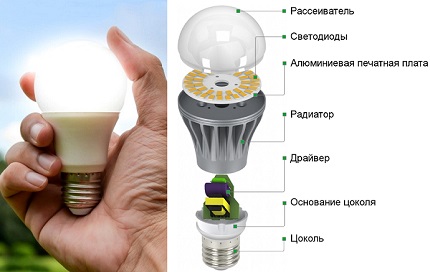
The increased interest in diodes is due to a number of significant advantages relative to incandescent lamps:
- profitability - electricity consumption is reduced by 8-10 times;
- durability - the service life is increased 20-40 times;
- preservation of brightness during voltage drops;
- slight heating of the bulb - there is no risk of burns on the LED lamp.
In a limited power lamp, you can install a brighter diode than an obsolete analogue with an incandescent spiral.
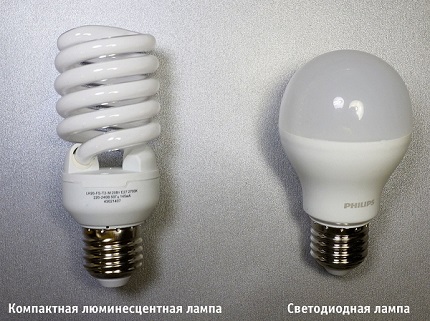
Diode bulbs still have drawbacks. The main disadvantages: high price and the availability of low-quality products. In addition, the ability to change the brightness is limited - dimming provided only in more expensive models.
Types of household LEDs: design differences
Lamps for the home are classified according to two main criteria: the type of LED and the design.
According to the first sign, three types of diodes are distinguished:
- SMD - single LEDs;
- COB - matrix of illuminators;
- Filament - diode thread.
SMD Single LEDs are suitable for mounting on the surface of the board. Their feature is directed light emission with a scattering angle of 100-130 °. Priority use: spotlights and LED strips.
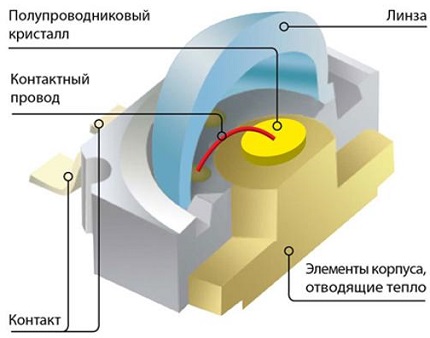
SMD diodes are durable because their design provides good heat dissipation, preventing the device elements from overheating even during continuous operation.
COB. The abbreviation is interpreted as Chip on Bord, in translation - the chip on the board. LEDs are a housing of various configurations with integrated SMD crystals.
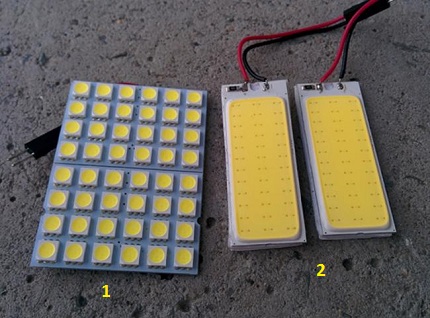
Lamps with "matrix" LEDs are not suitable for narrowly targeted lighting, but they are not able to cover the entire surrounding space - their angle of light scattering is less than 180 °.
Filament. The innovative LED is developed on the principle of COB, but here on one elongated cylindrical substrate there are many mini-crystals.
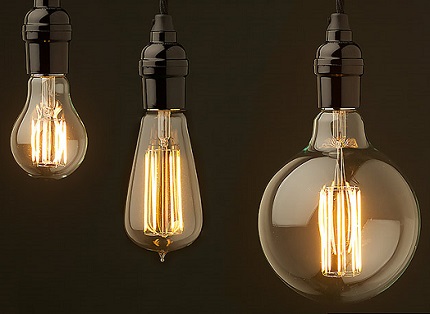
Based on the design, domestic diode lamps can conditionally be divided into three groups:
- standard models with a matte or transparent bulb;
- "Corn" with SMD or COD LEDs.
Standard. Traditional lamps produced in different forms: classic, candle, pear, elongated ball, ellipsoid, etc. The type of bulb depends on the LED used. The opaque case is characteristic for models with SMD or COD crystals, and transparent glass - for Filament lamps.
"Corn". Initially, all lighting equipment of this type was manufactured without a bulb. Open SMD diodes were placed on the cylindrical tube, which eliminated the risk of overheating. Later, single LEDs began to be replaced by more powerful COB-matrices.
Both options have the following advantages:
- the absence of a bulb increases the brightness of the glow by 25-40%;
- comprehensive lighting;
- maintainability;
- do not need a radiator, which affects the cost reduction.
The main disadvantage is the risk of contact with open contacts under voltage.
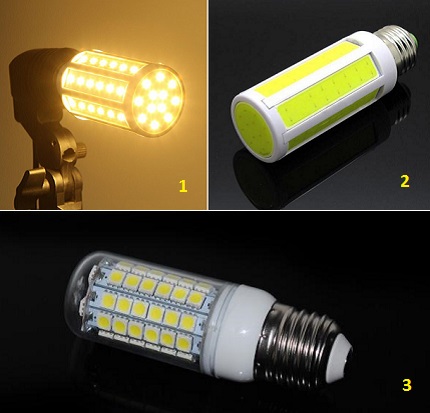
The last option is the least successful. The glass case conceals the contacts, but blocks the heat output. Such a flaw leads to a quick burnout of the lamp.
Guidelines for choosing LED bulbs
With the definition of a suitable LED spotlight, not everything is as simple as with the choice of an incandescent lamp. The power of the illuminator is far from the only parameter that must be considered when buying.
Luminous flux characteristics
The traditional power indicator, measured in watts, is not so relevant when choosing an LED lamp. It is incorrect to talk about the brightness of an LED illuminator based on its power consumption. Bulbs made by various technologies, with the same brightness of light, consume a different amount of electricity.
It is more correct to evaluate the equivalent of power, as well as the light flux.
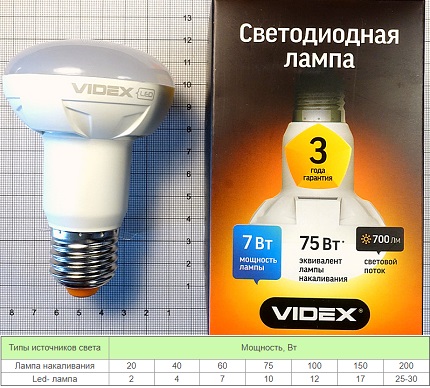
If this information is not displayed, then you can focus on the average indicator - the illumination from the LEDs is 5 times higher than the incandescent lamp with equal power consumption.
A more accurate idea of the quality of light gives the value of the luminous flux. The parameter characterizes the brightness of the lamp and is displayed in lumens. The choice of illumination depends on the purpose of the room.
Recommended standards according to SNiP 23-05-95 per 1 sq.m:
- kitchen, bedroom, living room - 150 lm;
- children's room, study - 200 lm;
- bathroom, hallway - 50 lm.
Knowing the area of the room, it is easy to calculate the required amount of luminous flux. The brightness value of the diode lamp, as well as the power, is indicated on the package. However, it is better to take a device with a small margin of illumination, as manufacturers often overestimate this characteristic.
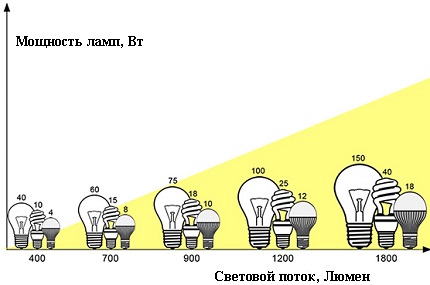
Color spectrum - glow temperature
The luminescence spectrum of LED lamps varies from warm yellowish to cool blue. Hue is determined by the color temperature, which is in the range of 1800-6600 ° K.
The choice of the tone of the glow depends on personal preferences, the purpose of the lighting and the surrounding interior. It is worth considering that all the colors of light are perceived by a person in different ways:
- 2700 K - warm white - promotes relaxation, rest, applicable in a cozy environment, such as a bedroom;
- 3000 K - yellow-white - a little colder than the previous one, recommended for the living room and the nursery;
- 3500 K - daylight white - increases efficiency; such lamps are suitable for cabinets and local mirror lighting;
- 4000-4800 K - neutral white - perfectly complements the hi-tech interiors, minimalism, but somewhat suppresses the feeling of comfort; spotlights are installed in public buildings and offices.
Luminaires with a luminous temperature of more than 5000 K are not recommended for home use. Their purpose is street lighting, industrial and warehouse facilities.
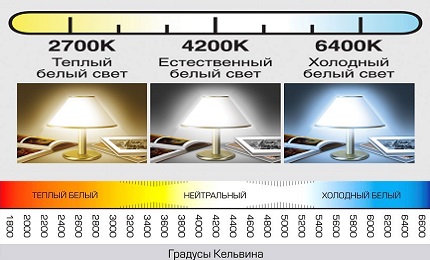
Color Rendering Index Value
Lamps of equal glow temperature can convey the colors of surrounding objects in different ways. Unlike incandescent bulbs, diode lamps have a limited spectrum, which can lead to distortion of the real picture.
The correctness of the perception of shades depends on the color rendering coefficient. The index is designated as CRI or Ra.
CRI is a relative value within 100, indicating how different colors are visible when illuminated by a lamp. The standard is sunlight, its CRI = 100. Incandescent bulbs have a high color rendering index - 97-98.
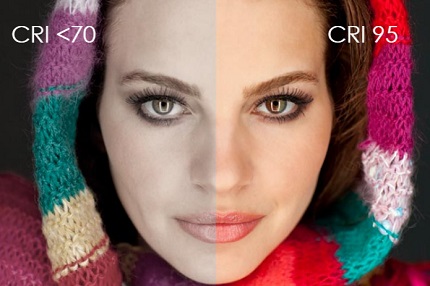
In detail about color temperature LED bulbs are described in the next article, the contents of which we advise you to read.
Light ripple coefficient
When thinking about how to choose a high-quality LED lamp for the home, many forget about such an important parameter as flickering. But it is precisely the pulsation of light that often causes eye fatigue and a general deterioration in well-being.
Often, manufacturers do not indicate the degree of flickering of the bulb. Significant ripple is perceived as a stroboscopic effect - with a sharp turn of the head or looking away.
It is possible to establish the presence of flicker experimentally. Point a pencil at the luminous lamp and quickly twist it in a semicircle. The absence of extraneous contours indicates safe lighting, if there are “a few pencils”, then the light pulsates.

The norms of SNiP established that the permissible coefficient of light pulsation for the workplace is 10-20%, of the living room - 30%. The requirements are put forward for ripples with a frequency within 300 Hz. The retina does not respond to flicker above 300 Hz.
High-quality diode light sources have a degree of flicker up to 5%, incandescent lamps - 8-32%.
Base type and operating voltage
LED bulbs are produced for different types of lamps, which allows you to choose a diode for any need. In everyday life, illuminators with the following socles are most in demand:
- E14, E27 - used primarily for floor lamps, chandeliers, wall sconces;
- GU 10, G4 - designed to replace a halogen bulb of the appropriate size and spotlight.
Most LED illuminators are powered by a voltage of 220 watts. With a high-quality driver, the lamp may not be afraid of surges on the electrification line. Some manufacturers pre-lay a wide voltage range - 110-220 watts.
A number of modifications are designed for 12 watts. To connect them, a pulse converter is required that provides stabilized voltage.
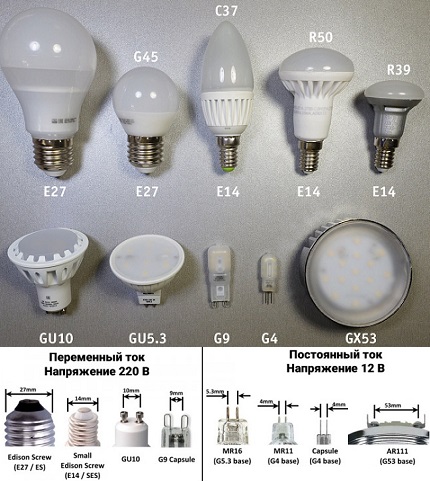
In the bulb labeling, the letter symbol indicates cap type, and the figure is its diameter or the distance between the contacts.
The dependence of the scattering angle on the shape of the flask
Due to the design features, LEDs emit light in a small angular range. In the absence of optical elements, the diode illuminates the front hemisphere. To expand the range of action, secondary optics are used: scattering, focusing lenses and polycarbonate frosted flasks.
The angular range of lighting depends on the shape of the lamp itself. Convex bulbs scatter light to a larger space.
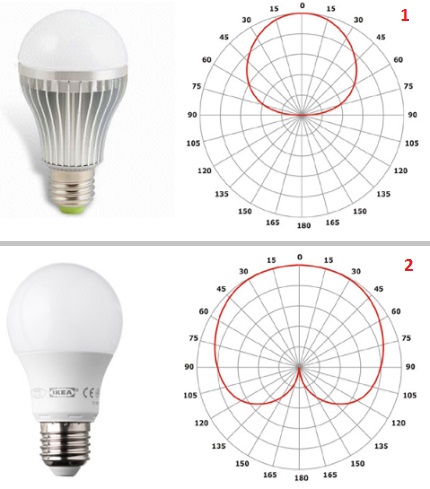
The first type of lamp is mainly used in fixtures, where the ceiling is directed downward - table lighting. The second type is similar to the action of incandescent lamps and is used to organize the main light.
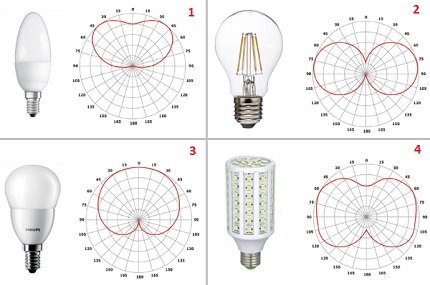
Of the above modifications, each has a specific spectrum of action and purpose:
- "candle" - the luminous flux is emitted in different directions, the front hemisphere is poorly lit; bulbs are suitable for chandeliers where the bulb is directed to the ceiling;
- Filament - suitable for general lighting, but not used to illuminate the workplace;
- ball-shaped flask - the range of action is 200-270 °, similar to incandescent lamps;
- "Corn" - a glow angle of 270 ° allows you to use the bulb as the main lighting.
LED luminaires with GU10 and MR16 socket operate in the range of 15-135 °. Conventionally, they can be classified into accent and general lighting.
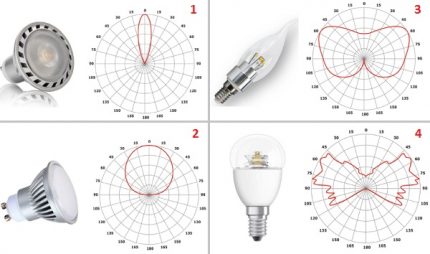
Unusual scattering of light have bulbs with a conical lens. Unlike models with frosted flasks, uneven dispersion is observed here. Such LEDs are suitable for lamps with shades and lampshades.
Attention to radiator quality
The heat sink function in LED lamps is performed by radiators. Coolers differ among themselves in material manufacturing and design.
The following options are possible:
- aluminum (ribbed and smooth);
- ceramic;
- composite;
- plastic.
Aluminum radiator. The metal cooler has a high thermal conductivity and is characterized by low weight.
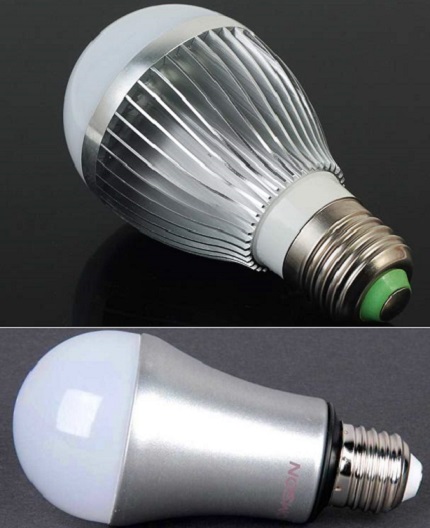
Plastic. Inexpensive option of diode illuminators with medium efficiency. The radiator is made of thermally dispersible polymer. To increase the thermal conductivity in the case make additional ventilation holes.
Composite The radiator is made of aluminum and enclosed in a thin plastic shell. Lamps with composite radiators are in demand due to the optimal price / quality tandem.
Ceramic Cooler. It looks like plastic, but the material is heavier and smoother to the touch. F17
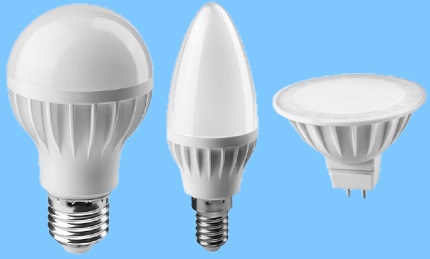
Do not rely on a ceramic radiator in cheap products. However, there is no point in avoiding plastic coolers - they serve for a long time and will definitely “work out” the money spent.
Lamps with corrugated aluminum or ceramic heatsink can be installed where the heat sink is critical. A vivid example is the fixtures built into furniture or the subceiling space of the stretch fabric.
Additional features of diode spotlights
LED bulbs are rightfully considered an intelligent device, some of them, in addition to performing the main task, have additional functionality. The most popular option is the ability to adjust the brightness of the glow.
This feature is not available in all. LED lights LED, but only on models with a built-in dimmer.
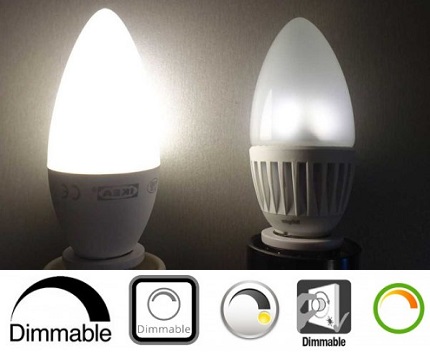
In some versions, RGB LEDs are installed, emitting the whole gamut of rainbow colors. For stand-alone operation, LED lamps are supplemented by a built-in supply battery.
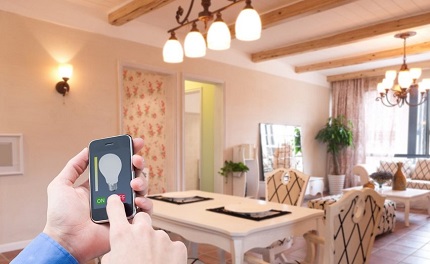
Service life and warranty period
The average period of operation of diode products is 10-40 thousand hours. This means working normally for about 3-4 years in a residential building. In practice, the life of the bulbs may exceed this value.
Recent developments of European and Japanese manufacturers allow us to talk about increasing the efficiency of lamps up to 100 thousand hours. And even after this period the illuminator continues to function, but with a decrease in brightness by 30-40%.
However, there are goods that fail during the first three to four months of operation. A quick breakdown is characteristic of Chinese cheap products.
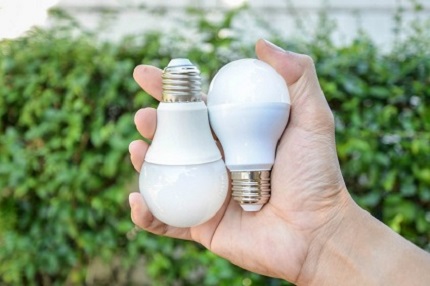
After acquiring a light bulb, you need to photograph the check. If the lamp fails prematurely, it will be possible to exchange it under warranty by presenting a photo if the check fades or is lost.
Overview of popular brands of LED products
The ranking of the most sought-after LED products is led by company bulbs Philips and Osram. European manufacturers tightly control the quality of their products. Of course, this approach affects the cost, but given the durability, their price is justified. The operating parameters of German lamps correspond to the declared characteristics.
A worthy and more affordable alternative is the products of Bioledex (Germany), FKK (Japan), Nichia (Japan).
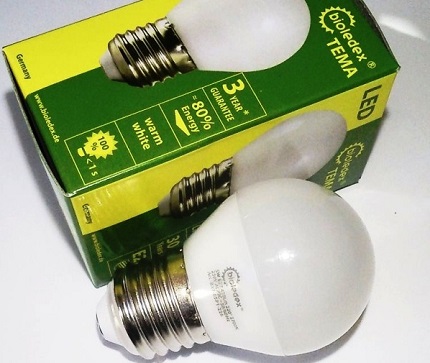
Among transnational and domestic projects, the products of the following companies received a decent rating:
- Newera (Russia / China) - a trademark of the SVeto-Led brand in the diode technology market for about 10 years, the main plus is the price / quality balance;
- Ecola (Russia / China) - has a developed retail sales network;
- Gauss (Russia) - the company is actively introducing the latest technologies, experimenting with design and quality control;
- ASD (Russia) - the level and safety of products are confirmed by the sign “Russian nanotechnological products”;
- Uniel (Russia) - the variety of LED lamp series, the main advantages of the goods: no flickering, high color rendering index, reasonable price, stylish design; Warranty - 2 years.
Separately, it is necessary to mention the Chinese-made diode lamps. Definitely not worth buying products from nameless manufacturers. Light bulbs from non-manufacturer manufacturers do not meet safety standards and declared specifications. In the best case, the spotlights will shine a bit and stop working, in the worst case it will harm others.
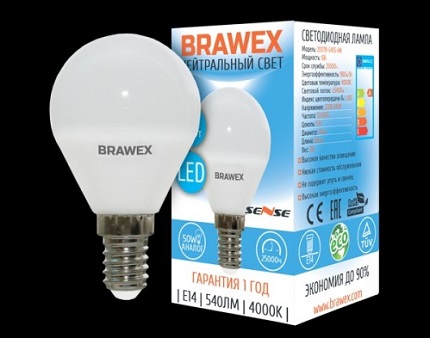
With landmarks dimmer selection For LED lighting devices, an article on this interesting issue will be introduced.
Conclusions and useful video on the topic
Detailed instruction on determining a high-quality diode light bulb, flicker test:
Testing products of popular brands. Advantages and disadvantages of Philips, Canyon and Osram lamps:
Replacing old incandescent bulbs with technologically advanced LED-illuminators has many positive aspects. In order for the LEDs to maximize their effectiveness and fully pay back the spent finances, you should correctly approach the question of their choice - to evaluate a number of parameters and check the performance.
Tell us about how LED bulbs were selected for installation at home / in the country / in the office. Share the criteria that helped you determine your purchase. Please leave comments, ask questions and post photos on the topic of the article in the block below.

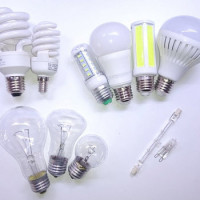 Which bulbs are best for the home: which are + rules for choosing the best bulb
Which bulbs are best for the home: which are + rules for choosing the best bulb 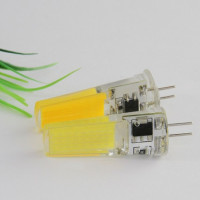 LED bulbs g4 to 12v: features, rules of choice + review of the best manufacturers
LED bulbs g4 to 12v: features, rules of choice + review of the best manufacturers 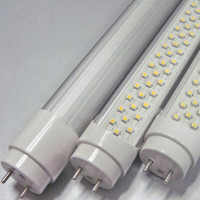 Replacing fluorescent lamps with LEDs: the reasons for the replacement, which are better, replacement instructions
Replacing fluorescent lamps with LEDs: the reasons for the replacement, which are better, replacement instructions 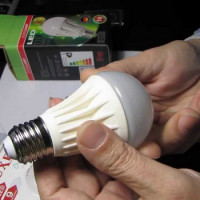 Which LED lamps are better to choose: types, characteristics, choice + best models
Which LED lamps are better to choose: types, characteristics, choice + best models 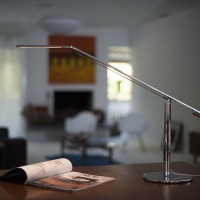 LED table lamps: types, selection rules + review of the best manufacturers
LED table lamps: types, selection rules + review of the best manufacturers 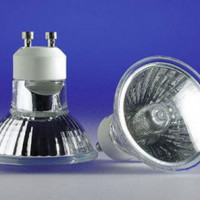 12 Volt Halogen Lamps: Overview, Features + Overview of Leading Manufacturers
12 Volt Halogen Lamps: Overview, Features + Overview of Leading Manufacturers  How much does it cost to connect gas to a private house: the price of organizing gas supply
How much does it cost to connect gas to a private house: the price of organizing gas supply  The best washing machines with dryer: model rating and customer tips
The best washing machines with dryer: model rating and customer tips  What is the color temperature of light and the nuances of choosing the temperature of the lamps to suit your needs
What is the color temperature of light and the nuances of choosing the temperature of the lamps to suit your needs  Replacement of a geyser in an apartment: replacement paperwork + basic norms and requirements
Replacement of a geyser in an apartment: replacement paperwork + basic norms and requirements
Incandescent lamps are a thing of the past. But the LED “competitors” that came to replace them also have a number of problems.For some manufacturers, lamps light up to maximum brightness within a few minutes, and there are also problems with voltage drops. In view of this, the lamps quickly burn out. Apparently, I came across a substandard brand.
I would not say that lamps with an aluminum radiator are light. The husband bought home such LEDs, so at first I even refused to screw them into the chandelier, because I was afraid that they would tear off the wires corny. They are really heavy. The heaviest lamps of all that I held. Then they screwed it all the same. Hang, t-t-t, normal flight.
I consider the huge advantage of most LED lamps to be the fact that they shine brightly immediately after switching on, and not as fluorescent ones that need time to light up. Sometimes I don’t have this time, a bright light is needed immediately and not for long.
As far as I remember, corn-type lamps are a thing of the past, as they were not very reliable. I myself use Gauss lamps. They make rather reliable lamps and not expensive.